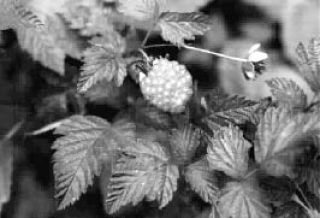Everyone’s talking about eating local in-season produce as the healthiest food to nourish their bodies. More and more people are supporting local farms in their quest to achieve the most wholesome diet. An excellent adjunct is to add a daily dose of the whole assortment of wild edibles available for foraging in copious amounts this time of year. Foliage, flowers, roots and berries of a variety of wild plants are in season on Vashon. Supplementing your diet with these foods is a potent source of raw natural vitamins, minerals, amino acids, bioflavinoids, and a host of other beneficial nutrients. It is the ultimate in food empowerment.
Salmonberries (Rubus spectabilis) are the first of the native berry bushes to produce their fruit. The young spring leaves and shoots are also edible, if a bit astringent and drying to the mouth. This astringency leads to their historical use as a treatment for colds and damp coughs. A medicinal tea can be made out of the leaves and twigs; I find it tastes best if you dry them first and then steep as you would a cup of tea.
You can also make a syrup by boiling the dried leaves until the water is reduced to half, then adding a generous amount of honey, which imparts its own antibacterial and throat-coating properties.
Now is a great time to collect salmonberry leaves for use in winter months. Instead of tossing those clipped branches aside, just hang them upside down in a dark room to dry. All members of the Rubus genus are considered an excellent ally for women, especially tonifying for the reproductive organs. Whenever an herb book recommends red raspberry leaf tea, you can safely substitute any of the leaves of our native Rubus species, including salmonberry, thimbleberry and Pacific trailing blackberry.
Indian plum, also called oso berry (Oemleria cerasiformis), is a conspicuous plant in the North-west in that it is the first of the woody stemmed plants to develop its leaves in early spring. The leaves of the Indian plum taste strongly of cucumber skins. As the berries first develop, they turn bright orange; at this stage they are still unripe and taste just like the leaves. As Indian plum berries ripen, they turn a deep shade of purple and soften up, looking just like tiny plums. They are one of the sweetest native fruits and fun to eat since their magenta dark juice stains fingers, teeth and tongue. They can also be soaked in vodka to make a wonderful Indian plum liqueur.
Flowers of the fringe cup, madrona, dandelion, geum and white clover can all be enjoyed raw now, or made into a variety of concoctions providing a palette of flavors. Young leaves of the sweet cicely, nipplewort, heal all, fireweed, as well as a smorgasbord of other wild edibles provide an unexpectedly diverse seasonal treat.
When you are thinking of eating local seasonal organic foods, you can’t get closer to the source than wild plant foraging. Of course, it is vitally important that you can correctly identify any plant you are about to ingest and that you know how to collect from a place free from pesticides. Learning to safely forage for wild foods will allow you to experience the diversity of native seasonal foods on our Island, greatly contributing to your health while delighting your palate.
— Erin Kenny will be leading an edible plants hike at Burton Acres from 10 a.m. to noon Saturday, June 21, as part of the “Walk on the Wild Side” program sponsored by the Vashon Park Department, Vashon Maury Island Land Trust and SEEDS.



